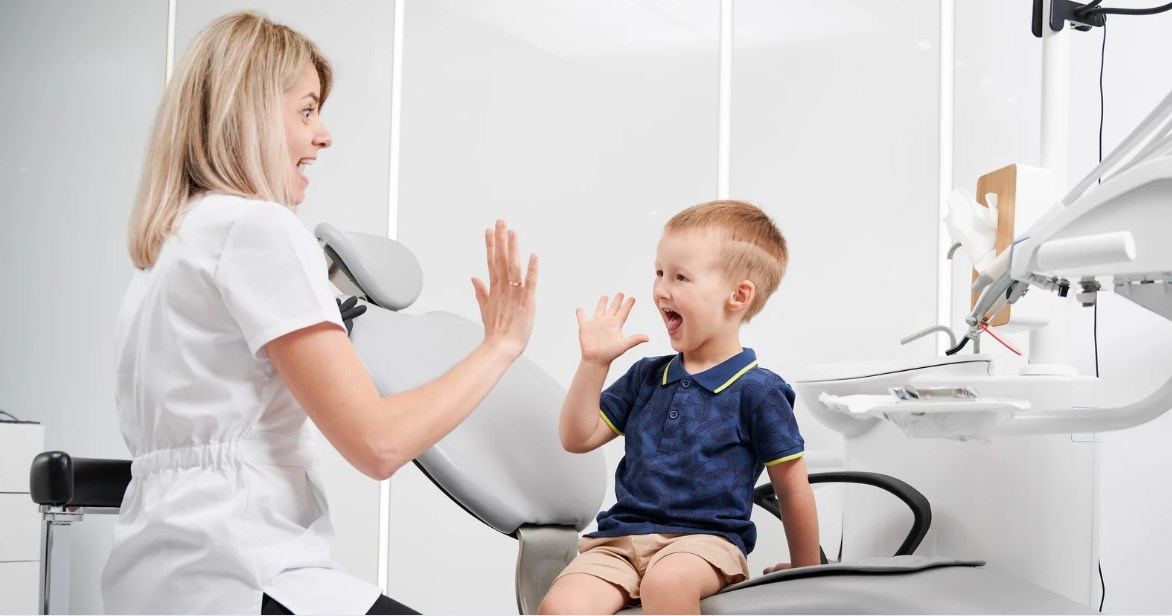
Top 10 Oral Health Milestones for Children



A child’s smile evolves with every stage of growth, and each phase comes with its own set of dental milestones. These milestones aren’t just about aesthetics—they play a critical role in your child’s overall health, nutrition, and self-confidence. Understanding what to expect as your child grows can help you guide them toward strong, healthy teeth for life. In this comprehensive guide, we explore the top 10 oral health milestones for children, from the eruption of the first tooth to the transition to permanent dentition. By knowing these milestones, you can help ensure that your child’s dental care remains on track, and address any issues early on.
Most children experience the eruption of their first tooth between 6 and 12 months of age, although the timing can vary widely. The first tooth to appear is typically one of the lower central incisors.
The arrival of the first tooth is a significant milestone. It not only marks the beginning of your child’s oral development but also signals the start of forming a proper bite. It’s crucial to start cleaning your child’s gums even before teeth emerge and to begin using a soft, damp cloth once the first tooth appears. Establishing a gentle oral hygiene routine early on sets the stage for preventing early childhood decay.
.
By around age 3, most children have a full set of 20 primary (baby) teeth. These teeth are essential for proper chewing, speech development, and maintaining space for permanent teeth.
The complete set of primary teeth plays a critical role in your child’s development. They help in forming proper speech and chewing food effectively, which is important for nutrition. These teeth also act as placeholders, guiding the eruption of permanent teeth later on. Even though primary teeth are temporary, they require the same level of care as permanent teeth to prevent early decay and maintain gum health.
.
The Canadian Dental Association recommends that children have their first dental visit by their first birthday or within six months after the first tooth erupts.
A dental visit early in life is about more than just checking for cavities—it’s about building a relationship with the dentist, addressing parental concerns, and educating both parents and children about proper oral hygiene. Early visits allow dentists to detect potential issues and guide parents on the best practices for their child’s oral care.
As children move from infancy to the toddler and preschool years (ages 1 to 5), establishing a consistent oral hygiene routine becomes critical.
By this stage, children begin to develop the motor skills needed for brushing their teeth. However, parental supervision remains essential to ensure proper technique and thorough cleaning. Regular brushing, flossing, and rinsing help prevent early childhood caries, also known as baby bottle tooth decay, and build habits that will last a lifetime.

Between the ages of 6 and 12, children experience mixed dentition—a transitional stage where they have both primary and permanent teeth.
During this phase, your child’s dental landscape changes dramatically. As permanent teeth begin to emerge, it’s essential to monitor the spacing and alignment of both sets of teeth. This period is also crucial for establishing oral habits that will influence the health and aesthetics of the permanent dentition. The mixed dentition phase can also be a time when children are more susceptible to cavities, making it even more important to maintain diligent oral hygiene.
Orthodontic evaluations typically begin around age 7, though the timing can vary depending on individual development.
During an orthodontic evaluation, a dentist or orthodontist examines your child’s bite, alignment, and overall dental structure. Early evaluation can help detect issues such as crowding, misalignment, or bite problems that might require intervention. Addressing these issues early can save time, reduce the need for more extensive treatment later, and ultimately contribute to a healthier, more aesthetically pleasing smile.
Dental sealants and fluoride treatments are often recommended during the early school years, once permanent molars begin to emerge, typically around age 6 to 9.
Sealants act as a protective coating on the chewing surfaces of the molars, where cavities are most likely to develop. Fluoride treatments help strengthen enamel and make teeth more resistant to decay. Both treatments serve as preventive measures that can significantly reduce the incidence of cavities during the critical period of dental development.
Dental emergencies can occur at any age, but early childhood is a time when accidents and injuries are more common, especially as children engage in sports and active play.
Accidents like chipped or knocked-out teeth require immediate attention to prevent long-term damage. Learning how to manage these emergencies, along with understanding when to seek professional help, is a critical part of pediatric dental care.
As children approach their teenage years, they start taking more responsibility for their oral hygiene. This transition can be challenging, but it’s a crucial step in ensuring lifelong dental health.
Transitioning to independent oral care means that children learn to manage their brushing, flossing, and other dental habits on their own. This period is critical for establishing routines that will last into adulthood. However, parents must continue to monitor and guide their children to ensure that proper techniques are maintained.
Long-term maintenance becomes a priority once your child has transitioned to a full set of permanent teeth. This milestone typically occurs in the early teenage years.
At this stage, establishing a robust, lifelong dental routine is essential. Regular dental visits, preventive treatments, and healthy lifestyle choices will contribute to the longevity of their smile. It’s also an ideal time to address any remaining issues, such as minor alignment problems or early signs of decay, to prevent more significant issues later in life.
While establishing a strong home care routine is vital, professional dental care plays an equally important role. Regular checkups allow your dentist to monitor growth, detect early signs of decay or gum disease, and provide preventive treatments that help keep your child’s smile in optimal condition. These visits are also opportunities for dental professionals to educate your family, update preventive measures, and address any concerns that may arise as your child’s teeth develop.
Every child’s dental journey is unique, marked by important milestones that contribute to a lifetime of healthy smiles. From the first tooth eruption to the transition to permanent dentition, each phase of development requires attention and care. By establishing strong oral hygiene habits early, setting family routines, and taking advantage of professional dental care, parents can ensure that their children enjoy a bright, healthy smile for years to come.
A balanced diet, consistent brushing and flossing, and regular dental visits work together to prevent cavities, gum disease, and other oral health issues. As your child grows, empowering them with the knowledge and tools to care for their teeth is one of the most valuable gifts you can provide.
If you’d like personalized guidance on your child’s dental development or want to schedule a check-up to ensure their smile remains on track, Contact Newbury Dental today to schedule an appointment. Let us help you build a healthy foundation for a lifetime of smiles!

We look forward to meeting you! Call 780-760-3033, email info@newburydental.ca, or request an appointment online to set up your first visit. We’ll be in touch soon!